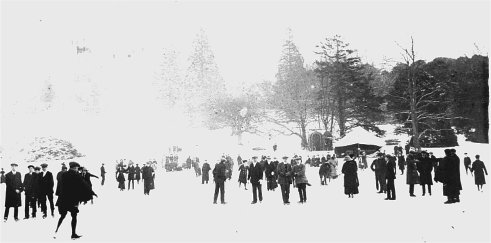Some indication of climate change might be obtained from the fact that, in earlier years, it could be reasonably relied upon that local ponds would regularly freeze over in winter time as the following newspaper report shows:
1914 – Skaters at Leigh Park right: Following the severe frosts on Thursday night, local skaters were eagerly anticipating a week-end of skating, and when the temperature fell rapidly on Friday their hopes began to rise equally. As the day broke, the sun looked on the countryside covered with a white mantle of hoar frost.
Several ponds in the vicinity of Emsworth had ice some inches in thickness, while the Hermitage was partially frozen over. The large pond in Leigh Park, Sir Frederick Fitzwygram’s estate, was frozen quite hard enough for skating, and was thrown open to the public by the kind permission of Sir Frederick. All the horse-drinking troughs in the district were covered in ice with varying thickness.

24 January 1914, Portsmouth Evening News
The ice on the lake in the Leigh Park gardens was often sufficiently thick enough to support many people at a time although sometimes skaters did come to grief at the following newspaper report records:
1895 (8 January) – Skating Accident. At Leigh Park, on Tuesday, several persons had the misfortune to break through the ice, one of them, a park employee, being immersed for a considerable time before he could be got out. Another visitor was rescued with some difficulty by Captain Healy and others who happened to be on the spot.
Portsmouth Evening News, 9 January 1895
1909 – The Severe Weather – Skating at Leigh Park: At Leigh Park also many skaters indulged in the winter sport yesterday evening, and the frost having continued all night it seems pretty certain that there would be a number of enthusiasts on the lake today.
29 January 1909, Portsmouth Evening News
Skating on Green Pond below in the early 1900s. No doubt the children were pupils from the original Warblington School opposite. The buildings on the right - now a convenience store, were originally a forge.
Many large houses had their own ice house in which ice from the ponds would be stored in order to keep food fresh during warmer weather. The remains of the Leigh Park house ice house can still be seen in Great Copse.